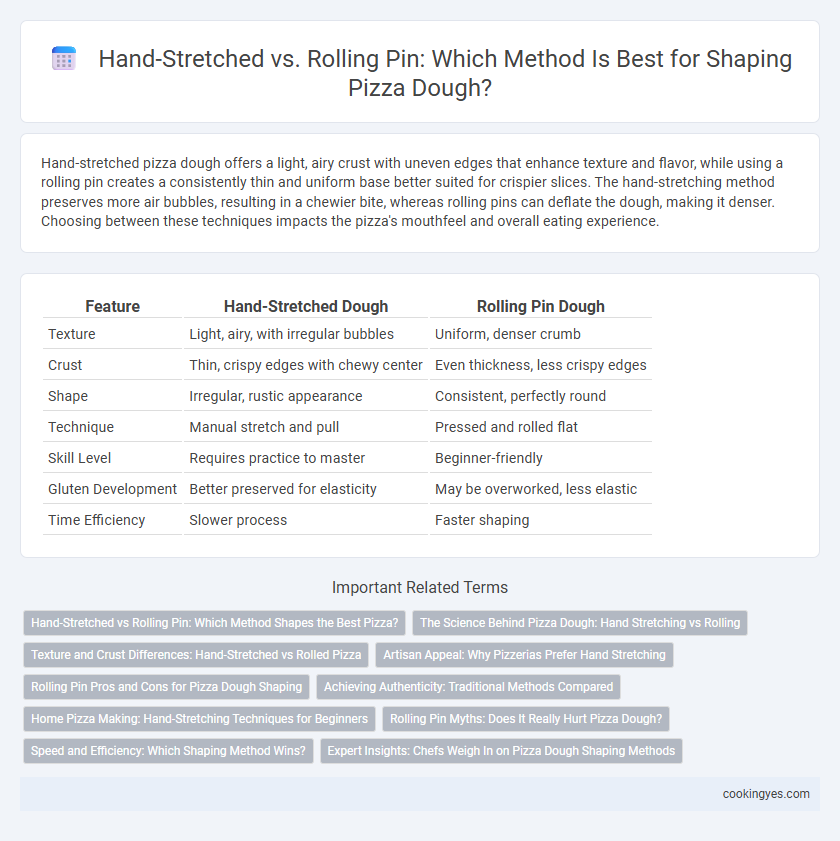Hand-stretched pizza dough offers a light, airy crust with uneven edges that enhance texture and flavor, while using a rolling pin creates a consistently thin and uniform base better suited for crispier slices. The hand-stretching method preserves more air bubbles, resulting in a chewier bite, whereas rolling pins can deflate the dough, making it denser. Choosing between these techniques impacts the pizza's mouthfeel and overall eating experience.
Table of Comparison
| Feature | Hand-Stretched Dough | Rolling Pin Dough |
|---|---|---|
| Texture | Light, airy, with irregular bubbles | Uniform, denser crumb |
| Crust | Thin, crispy edges with chewy center | Even thickness, less crispy edges |
| Shape | Irregular, rustic appearance | Consistent, perfectly round |
| Technique | Manual stretch and pull | Pressed and rolled flat |
| Skill Level | Requires practice to master | Beginner-friendly |
| Gluten Development | Better preserved for elasticity | May be overworked, less elastic |
| Time Efficiency | Slower process | Faster shaping |
Hand-Stretched vs Rolling Pin: Which Method Shapes the Best Pizza?
Hand-stretched dough preserves air bubbles, creating a light, airy crust ideal for Neapolitan-style pizza, while rolling pins produce a denser, more uniform base by compressing the dough. Artisan pizzerias favor hand-stretching to achieve an uneven, rustic texture that enhances flavor and chewiness. Rolling pins offer consistency and speed, but often sacrifice the dough's delicate structure crucial for the best pizza experience.
The Science Behind Pizza Dough: Hand Stretching vs Rolling
Hand-stretching pizza dough preserves the gas bubbles created during fermentation, resulting in a lighter, airier crust with better texture and flavor. Using a rolling pin compresses these bubbles, leading to a denser, less chewy dough by disrupting gluten structure and reducing dough elasticity. The science behind dough manipulation emphasizes that gentle hand-stretching maintains optimal gluten network integrity, crucial for achieving the ideal pizza crust.
Texture and Crust Differences: Hand-Stretched vs Rolled Pizza
Hand-stretched pizza dough produces a lighter, airier crust with a chewy texture due to the gentle stretching preserving air bubbles, while rolled dough creates a denser, thinner crust by compressing the dough and removing those bubbles. The artisanal technique of hand-stretching enhances the elasticity and uneven thickness, resulting in a more rustic and puffy edge, whereas rolling pin shaping yields a uniform thickness but a less textured bite. Texture and crust differences dramatically impact the final pizza experience, with hand-stretched crust favored for traditional Neapolitan-style pizzas and rolled crust often used for thin-crisp varieties.
Artisan Appeal: Why Pizzerias Prefer Hand Stretching
Hand-stretched pizza dough retains an artisanal texture that rolling pins often flatten, preserving air bubbles crucial for a light, chewy crust favored by pizzerias. This technique enhances dough elasticity and creates a rustic appearance emblematic of traditional Italian pizza craftsmanship. Chefs prefer hand stretching to maintain control over thickness and shape, ensuring each pizza has a unique, authentic appeal that resonates with customers seeking genuine artisan quality.
Rolling Pin Pros and Cons for Pizza Dough Shaping
Using a rolling pin for shaping pizza dough offers a consistent thickness and smooth surface, making it ideal for uniform crusts and quick preparation. However, rolling pins can compress the dough, potentially reducing the air bubbles that create a light, airy texture typical of hand-stretched pizzas. While convenient for beginners and precise size control, rolling pins may limit the dough's elasticity and result in a less chewy, more dense crust.
Achieving Authenticity: Traditional Methods Compared
Hand-stretched pizza dough preserves the airy texture and irregular edges characteristic of authentic Neapolitan pizza, allowing for natural gluten development and better dough elasticity. Rolling pins, while offering uniform thickness, often compact the dough, resulting in a denser crust that lacks traditional lightness and chewiness. The choice between hand-stretching and rolling pin shaping significantly influences the pizza's final texture, flavor profile, and adherence to time-honored artisanal standards.
Home Pizza Making: Hand-Stretching Techniques for Beginners
Hand-stretching pizza dough preserves the gluten structure, resulting in a lighter, airier crust compared to rolling pin methods which can compress and toughen the dough. Beginners benefit from hand-stretching by developing better control over dough thickness and creating characteristic irregular edges that enhance texture. Mastering gentle hand-stretching techniques, such as using gravity and fingertips, improves overall dough elasticity and yields traditional Neapolitan-style pizza bases at home.
Rolling Pin Myths: Does It Really Hurt Pizza Dough?
Using a rolling pin for shaping pizza dough can lead to a denser crust by compressing the air bubbles essential for a light, airy texture, a common concern among pizza enthusiasts. However, gentle rolling with minimal pressure does not necessarily harm the dough's structure and can be effective for achieving uniform thickness, especially in home kitchens. Understanding the dough's hydration and resting time is crucial, as well-rested doughs better withstand rolling without compromising quality, dispelling the myth that rolling pins always damage pizza dough.
Speed and Efficiency: Which Shaping Method Wins?
Hand-stretched pizza dough allows for faster shaping by using the elasticity of the gluten network, reducing the need for repeated rolling and maintaining air bubbles for a light crust. Rolling pins offer consistent thickness but can slow down the process due to extra handling and risk of deflating the dough. For speed and efficiency, hand-stretching is generally preferred in professional pizza-making environments.
Expert Insights: Chefs Weigh In on Pizza Dough Shaping Methods
Expert chefs emphasize that hand-stretched pizza dough preserves air bubbles, resulting in a lighter, chewier crust, while rolling pins can compress the dough, leading to a denser texture. Artisan pizzerias often favor hand-stretching for its ability to create varied thickness and maintain gluten structure, crucial for Neapolitan-style pizzas. Industry professionals highlight that mastering hand-stretching techniques enhances dough elasticity and overall pizza quality, despite requiring more skill and practice than using a rolling pin.
Hand-stretched vs Rolling pin for shaping Infographic

 cookingyes.com
cookingyes.com